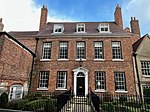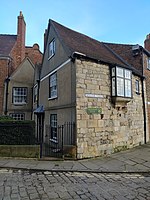Treasurer's House, York
Grade I listed buildings in YorkGrade I listed museum buildingsHistoric house museums in North YorkshireMinster YardMuseums in York ... and 3 more
National Trust properties in North YorkshireReportedly haunted locations in North East EnglandUse British English from August 2015

The Treasurer's House in York, North Yorkshire, England, is a Grade I listed historic house owned by the National Trust, who also maintain its garden. It is located in Minster Yard, directly to the north of York Minster.
Excerpt from the Wikipedia article Treasurer's House, York (License: CC BY-SA 3.0, Authors, Images).Treasurer's House, York
Minster Yard, York Bishophill
Geographical coordinates (GPS) Address Phone number Website External links Nearby Places Show on map
Geographical coordinates (GPS)
| Latitude | Longitude |
|---|---|
| N 53.963 ° | E -1.0808 ° |
Address
Treasurer's House
Minster Yard
YO1 7JL York, Bishophill
England, United Kingdom
Open on Google Maps











